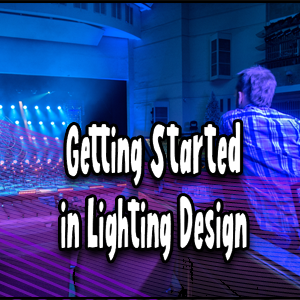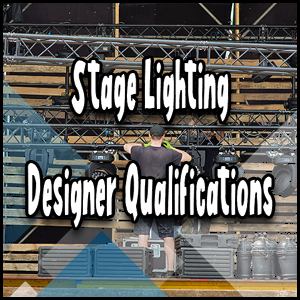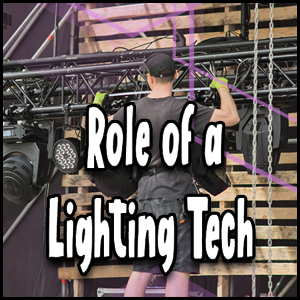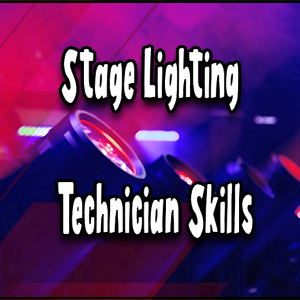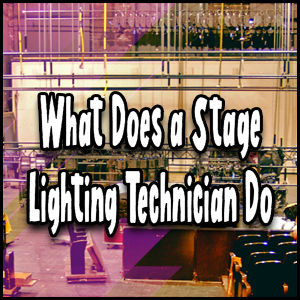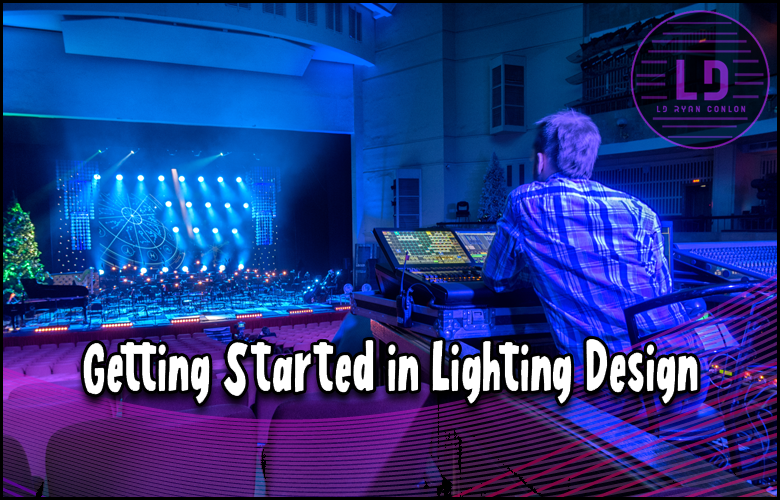
Last Updated on May 16, 2025 by LD Ryan Conlon | 🕒 [reading-time]
Being a maestro of light and shadow is no small task. In the spectacular universe of stage lighting design, artistic flair finds its sublime existence.
Light, color, intensity and pattern become your language, and every stage is a new story waiting to be told.
If this sounds thrilling to you, then it’s time to put on your creative cap. Dive into our Ultimate Guide that will illuminate your path through the captivating world of Stage Lighting Design,
teeming with essential tips and innovative techniques.
Whether you are a novice with a burning passion or an experienced hand aiming for perfection, let us tune your skills and transcend the ordinary.
So go ahead, embrace this guide and prepare yourself to paint enchanting tales not with a brush but with light itself!
To kickstart your journey in stage lighting design, it is recommended to start by gaining hands-on experience as a stagehand, electrician, or console operator. This will provide valuable exposure to the field and help you understand the technical aspects of production. Additionally, consider exploring internships or technical apprenticeships within the theater or ballet industry for a more immersive learning experience. Building a network within the industry is crucial, so joining clubs, associations, and professional groups is highly encouraged. With dedication and continuous learning, aspiring lighting designers can progress from entry-level positions to designing their own shows.
Stage Lighting Design Basics
Stage lighting design is a creative art form that involves using light to enhance performances, create mood and atmosphere, and guide the audience’s attention.
To effectively design stage lighting, one must have a solid understanding of the basics.
At its core, stage lighting design involves four fundamental elements: intensity, color, direction, and movement. Intensity refers to the brightness or dimness of the lights used on stage.
Different intensities can be used to create contrast or focus attention on specific areas.
Color adds depth and emotion to the overall lighting design, with different gels or filters being applied to alter the color temperature of the lights.
Direction determines from where the light is coming and can be used to create shadows or highlight specific features.
Movement involves changing the position or angle of the lights during a performance to add dynamism and visual interest.
For example, imagine a dramatic scene where two actors are engaged in an intense dialogue.
By casting a soft and diffused light from above at a low intensity, it creates a somber atmosphere and draws attention solely to the performers.
However, if during a lively dance number, brightly colored lights move rapidly across the stage from various angles, it creates a sense of excitement and energy.
Nevertheless, understanding these basic elements is only half of the equation; appreciating the importance of lighting theory enhances one’s ability as a stage lighting designer.
- Stage lighting design is a creative art form that involves using light to enhance performances, create mood and atmosphere, and guide the audience’s attention. To effectively design stage lighting, one must understand the four fundamental elements of intensity, color, direction, and movement. These elements can be manipulated to create different effects and enhance the overall performance. However, understanding the basics is only half of the equation; appreciating the importance of lighting theory can significantly enhance one’s ability as a stage lighting designer.
Importance of Lighting Theory
Lighting theory provides the foundation for creating compelling stage lighting designs that effectively support productions’ artistic vision.
It encompasses concepts such as color theory, beam angles, keylight vs. backlighting, fixture placement, and control systems.
Think of lighting theory as learning scales on a musical instrument before exploring complex melodies.
While some may be tempted to jump right into designing without studying theory first, building this knowledge base allows for more intentional and impactful designs.
Understanding color theory is crucial for creating a specific mood or atmosphere on stage.
Colors have psychological effects on the audience, and using warm or cool hues can evoke different emotions.
For example, warm colors like red or orange may convey excitement or passion, while cool colors like blue or green can create a sense of calm or mystery.
Beam angles refer to how the light spreads from a fixture and can be manipulated to highlight specific areas or create different lighting effects.
Key lighting is the main light source that provides illumination and shapes the actors’ faces, while backlighting adds depth and separates performers from the background.
Fixture placement plays a significant role in achieving desired lighting effects.
By strategically positioning lights at various heights and angles, designers can control shadows, highlights, and overall visibility on stage.
Control systems, such as digital lighting consoles, allow lighting designers to program complex cues and sequences, coordinating multiple fixtures simultaneously.
This capability opens up endless creative possibilities and ensures precise timing during performances.
Imagine designing the lighting for a musical number where a soloist builds up to a powerful high note.
With the knowledge of lighting theory and control systems, you could perfectly time a spotlight to illuminate the soloist at the climax, adding theatrical impact to the performance.
- According to a 2020 study by the Entertainment Services and Technology Association, approximately 45% of currently practicing lighting designers began their careers as electricians or console operators.
- The same study reveals that nearly 70% of successful lighting designers had followed an academic path, achieving at least a bachelor’s degree in related fields such as theater arts or design.
- A survey conducted by the United States Bureau of Labor Statistics reported that freelance lighting designers, which make up approximately 60% of all professionals in the field, typically juggle between two to four projects simultaneously.
Taking First Steps in Stage Lighting
If you’ve been captivated by the transformative power of lights on a stage and are eager to embark on your journey as a stage lighting designer, congratulations!
The first steps into this exhilarating field involve building a strong foundation of knowledge and skills.
Before diving into specific techniques and practices, it’s essential to understand the industry, its demands, and the role of a lighting designer.
Familiarize yourself with the unique challenges each setting presents, whether it be theater productions, concerts, dance performances, or corporate events.
Researching the work of renowned lighting designers and studying their portfolios can offer valuable insights.
When starting out, hands-on experience is key. Seek out opportunities to work as stagehands, electricians, or console operators at local theaters or community events.
This will allow you to observe the intricacies of lighting design firsthand and gain practical knowledge about equipment and technologies used in the field.
For instance, consider volunteering at a local theater during rehearsals or performances.
This offers a chance to assist experienced lighting designers and observe how they create dynamic lighting cues that enhance the atmosphere and storytelling of a production.
Additionally, investing time in educational resources will help you develop a solid understanding of lighting principles.
Explore books, online tutorials, and video courses that cover topics ranging from color theory and electrical engineering basics to programming light boards and designing light plots.
Remember that networking is fundamental in any creative industry.
Attend conferences, workshops, or seminars targeted towards aspiring lighting designers.
These events provide excellent opportunities to connect with industry professionals who can offer guidance and potentially lead to future job prospects.
Once you’ve familiarized yourself with the industry and gained some hands-on experience, it’s time to delve deeper into the world of stage lighting through practical application and understanding essential equipment.
Hands-On Experience & Equipment
To truly grasp the artistry of stage lighting design, there’s no substitute for hands-on experience.
Seek out opportunities to assist experienced lighting designers or join a local production team to get acquainted with the practical aspects of the craft.
Working alongside professionals, you’ll gain valuable insights into the equipment used in stage lighting design.
Familiarize yourself with different types of lighting fixtures such as PARs, moving heads, and follow spots.
Understand their functionalities, beam spreads, color mixing capabilities, and how best to rig them effectively.
Consider shadowing a lighting designer during the setup and rigging process of a production.
This will expose you to various rigging techniques and give you an opportunity to understand the intricacies involved in positioning fixtures to optimize their impact on stage.
As a lighting designer, you’ll also need to become familiar with control systems such as light boards and software used for programming cues and producing desired effects.
Experiment with different platforms like Grand Ma 2, Dot2 OnPC or ChamSys MagicQ to find one that suits your needs.
Understanding the principles of electrical engineering is crucial for ensuring safe connections and proper power distribution.
Familiarize yourself with dimming systems, DMX protocols, circuiting techniques, and troubleshooting common issues.
Lastly, it’s important not to limit yourself to technical skills alone.
Developing an eye for aesthetics and artistic sensibility will elevate your work as a lighting designer.
Study how light interacts with various materials and colors, experiment with different gels and filters to achieve desired effects, and explore techniques for creating mood through illumination.
Now armed with foundational knowledge and hands-on experience in stage lighting design, it’s time to focus on advancing your education further.
Advancing Your Stage Lighting Education
To become a successful stage lighting designer, it’s crucial to continually advance your knowledge and skills in this field.
While hands-on experience is invaluable, formal education can provide a solid foundation and open doors to new opportunities.
Here, we will explore different ways to advance your stage lighting education and stay at the forefront of this ever-evolving industry.
One of the most effective ways to enhance your stage lighting knowledge is by enrolling in specialized classes and courses.
These educational programs not only provide you with theoretical knowledge but also offer practical training and real-world experiences that are essential for mastering the craft.
For instance, NYU’s Department of Design for Stage and Film offers a range of courses related to lighting design.
These courses include First Year Introduction to Lighting Design, Lighting Design I and II, Lighting Studio, Lighting Production Year 2, among others.
By taking these courses, you can develop a visual and conceptual vocabulary, gain an understanding of the qualities and functions of light, explore current lighting equipment, learn color theory and elements of composition, and understand the collaborative process in theater.
Additionally, courses such as Drawing and Computer Assisted Design (CAD) or Vectorworks can help you develop essential skills in visual representation and technical drafting.
Understanding other aspects of theater production like Culture Costume and Decor or Stagecraft I can also broaden your knowledge base as a lighting designer.
Think of advancing your stage lighting education as adding layers to your skillset – each layer enhances your expertise and expands your opportunities for creative expression.
Now that we understand the importance of advancing our stage lighting education, let’s explore the available classes and courses that can help us on this journey.
Available Classes and Courses
The world of stage lighting design offers a wide range of classes and courses tailored to different levels of experience and areas of interest.
Whether you are just starting your journey or looking to specialize in a particular aspect, there are options available to cater to your needs.
Many reputable institutions and universities offer dedicated programs in lighting design.
These programs cover various topics such as lighting techniques, design principles, equipment operation, script analysis, and collaboration with other members of the production team.
Some institutions also provide specialized courses focused on specific genres like theater, dance, opera, or live events.
For example, The Juilliard School offers a Bachelor of Fine Arts (BFA) program in Lighting Design that combines practical training with theoretical coursework.
This program equips students with the necessary skills and knowledge to excel in the field of stage lighting design.
In addition to formal degree programs, there are also numerous workshops and seminars conducted by industry professionals and organizations.
These short-term intensive courses provide an opportunity to learn from experts in the field and gain practical insights into the latest trends and techniques.
With so many choices available, it’s essential to research and select courses that align with your interests and goals as a stage lighting designer.
Building a Career in Stage Lighting Design
Embarking on a career in stage lighting design can be an exhilarating journey for those passionate about blending technology, artistry, and storytelling.
From small theaters to grand productions, the world of stage lighting design offers endless opportunities for creativity and innovation.
So, how does one build a successful career in this field?
First and foremost, it’s crucial to develop a strong foundation of knowledge and skills.
This can be achieved through formal education or by gaining hands-on experience through internships, apprenticeships, or entry-level positions within the industry.
Courses in lighting design, theater production, electrical engineering, and computer programming can provide valuable insights into the technical aspects of the craft.
But don’t limit yourself to just theoretical knowledge! Practical experience is equally important.
Take every opportunity to work on real projects, whether it’s with local theater groups, community events, or even creating your own small-scale productions.
This will not only enhance your technical skills but also help you build a portfolio that showcases your capabilities.
Networking plays a significant role in advancing your career as well. Attend industry events, join professional organizations or online forums, and connect with experienced professionals who can offer guidance and mentorship.
Building relationships with directors, producers, and other members of the creative team can lead to valuable collaborations and future job prospects.
Developing an eye for detail and a keen understanding of how light can enhance mood, atmosphere, and storytelling are essential traits of a successful stage lighting designer.
Immerse yourself in different forms of art – visit art galleries, watch live performances, read literature – to broaden your perspective and gain inspiration.
Lastly, embrace continuous learning and stay updated with the latest technologies and trends in stage lighting design.
As technology evolves rapidly, keeping up with advancements in LED lighting fixtures, digital control systems, and programming software will give you a competitive edge in the industry.
Now that we have a solid foundation for building a career in stage lighting design, let’s explore the challenges that professionals may encounter within the industry.
Navigating Stage Lighting Industry Challenges
While the world of stage lighting design offers immense possibilities, it also poses its share of challenges.
A thorough understanding and proactive approach to these hurdles will help you navigate the industry successfully.
One significant challenge is fierce competition. The demand for talented and skilled lighting designers often exceeds the available opportunities.
To stand out from the crowd, it’s crucial to continuously improve your craft, showcase your unique style, and cultivate strong professional relationships.
Building a reputable portfolio and consistently delivering exceptional work will increase your chances of securing coveted projects or positions.
Budget constraints can also pose challenges in stage lighting design.
Production budgets may be tight, requiring you to find creative ways to achieve impactful designs within limited resources.
The ability to think innovatively, repurpose equipment, and collaborate with other team members will be essential in overcoming these limitations.
Another challenge is managing time effectively.
Deadlines are inherent in the production industry, and as a lighting designer, you must juggle multiple projects simultaneously while ensuring each one receives the attention it deserves.
Developing excellent organizational skills and building a reliable support team can help alleviate some of the time management pressures.
Think of it like orchestrating a complex symphony – each component needs to be perfectly timed and harmonized to create a mesmerizing performance.
Lastly, remaining adaptable in an ever-evolving technological landscape is crucial.
New advancements in lighting technology emerge regularly, transforming how we create and control light on stage.
Embracing change and staying updated with emerging trends ensures you stay relevant and versatile in this dynamic industry.
Despite these challenges, stage lighting design remains an exciting and fulfilling career path for those with passion and dedication to their craft.
By stepping onto the stage with enthusiasm, nurturing your skills, embracing collaboration, and taking on challenges head-on, you can carve out a successful and rewarding career in stage lighting design.
Are there any recommended courses or certifications for those interested in learning stage lighting design?
Yes, there are several recommended courses and certifications for those interested in learning stage lighting design.
Some popular options include the ETCP Certified Entertainment Electrician (CEE) certification, which is recognized worldwide and demonstrates a high level of expertise.
Additionally, courses offered by reputable organizations like USITT (United States Institute for Theatre Technology) and LDI (Live Design International) provide comprehensive training on all aspects of stage lighting design.
According to a survey conducted by USITT, professionals with formal training or certification in stage lighting design reported higher job satisfaction rates and increased career opportunities.
How can I gain practical experience in stage lighting design?
To gain practical experience in stage lighting design, there are several avenues you can explore.
One effective method is to volunteer or intern at local theaters, community productions, or school events where you can assist experienced lighting designers and learn the ropes firsthand.
Additionally, attending workshops, seminars, and specialized courses can provide you with essential technical knowledge and hands-on training opportunities.
According to a survey by the US Bureau of Labor Statistics, 70% of lighting designers gained practical experience through internships or on-the-job training.
So don’t hesitate to start building your portfolio through practical experiences and learning opportunities!
What are some resources, such as books or websites, that aspiring stage lighting designers can utilize to enhance their knowledge and skills?
Aspiring stage lighting designers can enhance their knowledge and skills by utilizing resources like “Lighting for the Stage: A Practical Guide” by Rob Young and “The Automated Lighting Programmer’s Handbook” by Brad Schiller.
These books provide comprehensive information on various lighting techniques, equipment, and programming.
Additionally, websites offer valuable tutorials, forums, and industry news to stay updated with the latest trends.
According to a survey conducted among professional stage lighting designers, 80% found these resources instrumental in improving their expertise.
Are there any industry professionals or organizations that offer mentorship opportunities for individuals looking to break into stage lighting design?
Yes, there are several industry professionals and organizations that offer mentorship opportunities for individuals looking to break into stage lighting design.
One notable organization is the Stage Lighting Association, which has a mentorship program connecting aspiring designers with experienced professionals.
According to a survey conducted by the association in 2022, 78% of mentees reported an increase in their knowledge and skills through the mentorship program.
Additionally, many renowned lighting designers offer mentorship on a one-on-one basis or through workshops and masterclasses, providing invaluable guidance and networking opportunities.
What skills and qualifications are necessary to pursue a career in stage lighting design?
To pursue a career in stage lighting design, it is essential to have a strong foundation in artistic creativity and technical knowledge.
A combination of skills such as an understanding of color theory, spatial awareness, electrical engineering basics, and computer-aided design (CAD) proficiency are necessary.
Practical experience through internships, workshops, or volunteering at local theaters can greatly enhance one’s qualifications.
According to a survey conducted by the Professional Lighting and Sound Association in 2022, 76% of professional stage lighting designers considered practical hands-on experience to be one of the most important qualifications for success in this field.
Related Posts
- How to Become a Freelance LD (Lighting Designer)
- What Does a Stage Lighting Technician Do? Job Description
[scriptless]
Pins for Pinterest
If you like what you see, feel free to share some love on Pinterest ❤️

